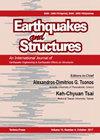基于改进IDA方法的隧道横向地震易损性分析
IF 1.1
4区 工程技术
Q3 ENGINEERING, CIVIL
引用次数: 2
摘要
脆弱性分析是研究隧道抗震性能的重要方法。选取圆形和矩形两个隧道基准截面作为研究对象,对隧道的横向地震特性进行了研究。利用SAP2000软件建立了有限元模型,讨论了不同场地类型、隧道埋深和断面尺寸对隧道横向抗震能力的影响。利用改进的增量动力分析方法确定了地震动烈度测量的概率地震需求模型和工程需求参数,并通过分析四个评价标准,确定了合理的地震动烈度措施。通过将概率地震需求模型与工程需求参数的限制相结合,计算出各地震烈度下结构的失效概率和结构的地震易损性曲线,以评估隧道的横向抗震性能。数值结果表明,PGA是适用于隧道横向抗震性能的地震动强度指标。场地类型对结构损伤的影响最为显著,地震作用下场地类型IV最为危险。隧道在弹塑性阶段具有更好的抗震性能,埋深较大的隧道比埋深较小的隧道更危险。大横截面隧道比小横截面隧道有更高的损坏概率。本文章由计算机程序翻译,如有差异,请以英文原文为准。
Transverse seismic vulnerability analysis of tunnels based on modified IDA method
Vulnerability analysis is a crucial method to study the seismic performance of tunnels. Two benchmark cross-sections of tunnels, namely circular and rectangular cross-sections, are selected as the research object to investigate the transverse seismic property of tunnels. A finite element model is established by SAP2000 software, and the influences of various site types, depths of burial of the tunnel, and cross-section sizes on the transverse seismic capacity of a tunnel are discussed. The probabilistic seismic demand model of ground motion intensity measures and the engineering demand parameters are determined by utilizing a modified incremental dynamic analysis (IDA) method, and the reasonable ground motion intensity measures are specified by analyzing four evaluation criteria. The failure probability of the structure under each earthquake intensity and the seismic vulnerability curve of the construction are calculated to evaluate the transverse seismic performance of the tunnel by combining the probabilistic seismic demand model with the limits on the engineering demand parameters. The numerical results indicate that PGA is the ground motion intensity measure suitable for the transverse seismic performance of the tunnels. The site type has the most significant influence on the structural damage, and site type IV is the most dangerous under an earthquake. The tunnel has better seismic resistance in the elastoplastic stage, and a tunnel with a large depth of burial is more hazardous than the one with a small depth of burial. A tunnel with a large cross-section has a higher probability of damage than the one with a small cross-section.
求助全文
通过发布文献求助,成功后即可免费获取论文全文。
去求助
来源期刊

Earthquakes and Structures
ENGINEERING, CIVIL-ENGINEERING, GEOLOGICAL
CiteScore
2.90
自引率
20.00%
发文量
0
审稿时长
>12 weeks
期刊介绍:
The Earthquakes and Structures, An International Journal, focuses on the effects of earthquakes on civil engineering structures. The journal will serve as a powerful repository of technical information and will provide a highimpact publication platform for the global community of researchers in the traditional, as well as emerging, subdisciplines of the broader earthquake engineering field. Specifically, some of the major topics covered by the Journal include: .. characterization of strong ground motions, .. quantification of earthquake demand and structural capacity, .. design of earthquake resistant structures and foundations, .. experimental and computational methods, .. seismic regulations and building codes, .. seismic hazard assessment, .. seismic risk mitigation, .. site effects and soil-structure interaction, .. assessment, repair and strengthening of existing structures, including historic structures and monuments, and .. emerging technologies including passive control technologies, structural monitoring systems, and cyberinfrastructure tools for seismic data management, experimental applications, early warning and response
 求助内容:
求助内容: 应助结果提醒方式:
应助结果提醒方式:


